Long-Term Prediction of Weather for Analysis of Residential Building Energy Consumption in Australia
Abstract
:1. Introduction
2. Methodology
2.1. Prediction of Future Weather Files
2.1.1. RCP Scenarios
2.1.2. Climate Zones
2.1.3. GCM Model Selections
2.2. Simulation of the Heating and Cooling Loads
3. Case Study
| Specification | House 1 | House 2 |
|---|---|---|
| External walls | Steel cladding on 90 mm studs with 1 R1.0 bulk insulation fitted between the studs and 10 mm plasterboard inner surface. Colour: Medium | 230 mm brick veneer with bulk insulation fitted between a 40 mm vertical air gap and the 10 mm plasterboard’s inner surface Colour: Medium |
| Floor | Concrete slab on the ground | Concrete slab on the ground |
| Ceilings | 13 mm plasterboard. R2.0 bulk insulation | 13 mm plasterboard. Bulk insulation |
| Roof | Continuous surface. Steel deck, light colour | Continuous surface. Metal deck, light colour |
| Awning windows and sliding doors | Timber frames with single glazing. Medium gap size. No weather strips or seals. Internal Holland blinds. No flywire screens or doors. No external blinds. | Timber frames with double glazing. Weather-stripped. Internal Holland blinds. No flywire screens or doors. No external blinds. |
3.1. Future Temperatures
3.2. Space H/C Energy Requirements and Star Ratings in the Future (2030–2100)
4. Discussion
5. Conclusions
Author Contributions
Funding
Institutional Review Board Statement
Informed Consent Statement
Data Availability Statement
Conflicts of Interest
References
- COAG Energy Council. Report for Achieving Low Energy Homes 2018. Available online: https://www.energy.gov.au/publications/report-achieving-low-energy-existing-homes (accessed on 25 June 2021).
- King, A.; Karoly, D.; Henley, B. Australian climate extremes at 1.5 °C and 2 °C of global warming. Nat. Clim. Chang. 2017, 7, 412–416. [Google Scholar] [CrossRef]
- Ren, Z.; Chen, D.; James, M. Evaluation of a whole-house energy simulation tool against measured data. Energy Build. 2018, 171, 116–130. [Google Scholar] [CrossRef]
- National Construction Code 2019. Building Code of Australia, Volume 1. Australian Building Codes Board. Available online: http://www.abcb.gov.au (accessed on 25 June 2021).
- IPCC AR5 Synthesis Report. Climate Change 2014. Available online: http://www.ipcc.ch/report/ar5/ (accessed on 25 June 2021).
- Van Vuuren, D.P.; Edmonds, J.; Kainuma, M.; Riahi, K.; Thomson, A.; Hibbard, K.; Hurtt, G.C.; Kram, T.; Krey, V.; Lamarque, J.F.; et al. The representative concentration pathways: An overview. Clim. Chang. 2011, 109, 5–31. [Google Scholar] [CrossRef]
- Xu, P.; Huang, Y.J.; Miller, N.; Schlegel, N.; Shen, P. Impacts of climate change on building heating and cooling energy patterns in California. Energy 2012, 44, 792–804. [Google Scholar] [CrossRef]
- Shen, P. Impacts of climate change on U.S. building energy use by using downscaled hourly future weather data. Energy Build. 2017, 134, 61–70. [Google Scholar] [CrossRef]
- Invidiata, A.; Ghisi, E. Impact of climate change on heating and cooling energy demand in houses in Brazil. Energy Build. 2016, 130, 20–32. [Google Scholar] [CrossRef]
- Kalvelage, K.; Passe, U.; Rabideau, S.; Takle, E.S. Changing climate: The effects on energy demand and human comfort. Energy Build. 2014, 76, 373–380. [Google Scholar] [CrossRef]
- Wang, X.; Chen, D.; Ren, Z. Assessment of climate change impact on residential building heating and cooling energy requirement in Australia. Build. Environ. 2010, 45, 1663–1682. [Google Scholar] [CrossRef]
- Belcher, S.; Hacker, J.; Powell, D. Constructing design weather data for future climates. Build. Serv. Eng. Res. Technol. 2005, 26, 49–61. [Google Scholar] [CrossRef]
- Wang, H.; Chen, Q. Impact of climate change heating and cooling energy use in buildings in the United States. Energy Build. 2014, 82, 428–436. [Google Scholar] [CrossRef] [Green Version]
- Ren, Z.; Paevere, P.; Chen, D. Feasibility of off-grid housing under current and future climates. Appl. Energy 2019, 241, 196–211. [Google Scholar] [CrossRef]
- Flores-Larsen, S.; Filippin, C.; Barea, G. Impact of climate change on energy use and bioclimatic design of residential buildings in the 21st century in Argentina. Energy Build. 2019, 184, 216–229. [Google Scholar] [CrossRef]
- Wang, L.; Liu, X.; Brown, H. Prediction of the impacts of climate change on energy consumption for a medium-size office building with two climate models. Energy Build. 2017, 157, 218–226. [Google Scholar] [CrossRef]
- Arima, Y.; Ooka, R.; Kikumoto, H.; Yamanaka, T. Effect of climate change on building cooling loads in Tokyo in the summers of the 2030s using dynamically downscaled GCM data. Energy Build. 2016, 114, 123–129. [Google Scholar] [CrossRef]
- Sabunas, A.; Kanapickas, A. Estimation of climate change impact on energy consumption in a residential building in Kaunas, Lithuania, using HEED Software. Energy Procedia 2017, 128, 92–99. [Google Scholar] [CrossRef]
- Frank, T. Climate change impacts on building heating and cooling energy demand in Switzerland. Energy Build. 2005, 37, 1175–1185. [Google Scholar] [CrossRef]
- Liu, Y.; Stouffs, R.; Tablada, A.; Wong, N.H.; Zhang, J. Comparing micro-scale weather data to building energy consumption in Singapore. Energy Build. 2017, 152, 776–791. [Google Scholar] [CrossRef]
- Pérez-Andreu, V.; Aparicio-Fernández, C.; Martínez-Ibernón, A.; Vivancos, J.L. Impact of climate change on heating and cooling energy demand in a residential building in a Mediterranean climate. Energy 2018, 165, 63–74. [Google Scholar] [CrossRef]
- Hekkenberg, M.; Moll, H.; Uiterkamp, S. Dynamic temperature dependence patterns in future energy demand models in the context of climate change. Energy 2009, 34, 1797–1806. [Google Scholar] [CrossRef]
- Seljom, P.; Rosenberg, E.; Fidje, A.; Haugen, J.; Meir, M.; Rekstad, J.; Jarlset, T. Modelling the effects of climate change on the energy system—A case study of Norway. Energy Policy 2011, 39, 7310–7321. [Google Scholar] [CrossRef]
- Zhu, M.; Pan, Y.; Huang, Z.; Xu, P. An alternative method to predict future weather data for building energy demand simulation under global climate change. Energy Build. 2016, 113, 74–86. [Google Scholar] [CrossRef]
- Ma, Q.; Yang, H.; Zhang, C.; Peng, Z. Effects of global warming for building energy demand in China. Comput. Model. New Technol. 2014, 4, 3–7. [Google Scholar]
- Pretlove, S.; Oreszczyn, T. Climate change: Impact on the environmental design of buildings. Build. Serv. Eng. Res. Technol. 1998, 19, 55–58. [Google Scholar] [CrossRef]
- Cartalis, C.; Synodinou, A.; Proedrou, M.; Tsangrassoulis, A.; Santamouris, M. Modifications in energy demand in urban areas as a result of climate changes: An assessment for the southeast Mediterranean region. Energy Conversat. Manag. 2001, 42, 1647–1656. [Google Scholar] [CrossRef]
- Akpinar-Ferrand, E.; Singh, A. Modelling increased demand of energy for air conditioners and consequent CO2 emissions to minimize health risks due to climate change in India. Environ. Sci. Policy 2010, 13, 702–712. [Google Scholar] [CrossRef]
- Pyrgou, A.; Castaldo, V.; Pisello, A.; Cotana, F.; Santamouris, M. Differentiating responses of weather files and local climate change to explain variations in building thermal-energy performance simulations. Solar Energy 2017, 153, 224–237. [Google Scholar] [CrossRef]
- Pisello, A.; Pignatta, G.; Castaldo, V.; Cotana, F. The impact of local microclimate boundary conditions on building energy performance. Sustainability 2015, 7, 9207–9230. [Google Scholar] [CrossRef] [Green Version]
- Waddicor, D.; Fuentes, E.; Sisó, L.; Salom, J.; Favre, B.; Jiménez, C.; Azar, M. Climate change and building ageing impact on building energy performance and mitigation measures application: A case study in Turin, northern Italy. Build. Environ. 2016, 102, 13–25. [Google Scholar] [CrossRef]
- Roshan, G.; Orosa, J.; Nasrabadi, T. Simulation of climate change impact on energy consumption in buildings, case study of Iran. Energy Policy 2012, 49, 731–739. [Google Scholar] [CrossRef]
- Dirks, J.; Gorrissen, W.; Hathaway, J.; Skorski, D.; Scott, M.; Pulsipher, T.; Huang, M.; Liu, Y.; Rice, J. Impacts of climate change on energy consumption and peak demand in buildings: A detailed regional approach. Energy 2015, 79, 20–32. [Google Scholar] [CrossRef] [Green Version]
- Nateghi, R.; Mukherjee, S. A multi-paradigm framework to assess the impacts of climate change on end-use energy demand. PLoS ONE 2017, 12, e0188033. [Google Scholar] [CrossRef] [PubMed] [Green Version]
- Mendoza, D.; Bianchi, C.; Thomas, J.; Ghaemi, Z. Modelling county-level energy demands for commercial buildings due to climate variability with prototype building simulation. World 2020, 1, 7. [Google Scholar] [CrossRef]
- Bianchi, C.; Mendoza, D.; Didier, R.; Thomas, T.; Smith, A. Energy demands for commercial buildings with climate variability based on emission scenarios. In Proceedings of the ASHRAE 2017 Winter Conference, Las Vegas, NV, USA, 28 January–1 February 2017. [Google Scholar]
- Kikumoto, H.; Ooka, R.; Arima, Y.; Yamanaka, T. Study on the future weather data considering the global and local climate change for building energy simulation. Sustain. Cities Soc. 2015, 14, 404–413. [Google Scholar] [CrossRef]
- Chan, A. Developing future hourly weather files for studying the impact of climate change on building energy performance in Hong Kong. Energy Build. 2011, 43, 2860–2868. [Google Scholar] [CrossRef]
- Whetton, P.; Hennessy, K.; Clarke, J.; McInnes, K.; Kent, D. Use of Representative Climate Futures in impact and adaptation assessment. Clim. Chang. 2012, 115, 433–442. [Google Scholar] [CrossRef]
- Clarke, J.; Whetton, P.; Hennessy, K. Providing application-specific climate projections datasets: CSIRO’s Climate Futures Framework. In Proceedings of the 19th International Congress on Modelling and Simulation, Perth, WA, Australia, 12–16 December 2011. [Google Scholar]
- The Climate Future Framework. Available online: https://www.climatechangeinaustralia.gov.au/en/projections-tools/climate-futures-tool/projections/ (accessed on 25 May 2021).
- Liley, B. Creation of 2016 NatHERS Reference Meteorological Years; NIWA Client Report No. 2017103WN, Prepared for Australian Government Department of Environment and Energy; Nationwide House Energy Rating Scheme: Canberra, ACT, Australia, 2017. [Google Scholar]
- Nakicenovic, N.; Swart, R. Emission Scenarios -Special Report of the Intergovernmental Panel on Climate Change; Cambridge University Press: Cambridge, UK, 2000. [Google Scholar]
- Nationwide House Energy Rating Scheme (NatHERS). Available online: http://www.nathers.gov.au (accessed on 25 May 2021).
- Köppen Climate Classification System. Available online: https://en.wikipedia.org/wiki/köppen_climate_classification (accessed on 16 June 2021).
- Climate Change in Australia. Available online: http://www.climatechangeinaustralia.gov.au/en/ (accessed on 25 June 2021).
- Walsh, P.; Delsante, A. Calculation of the thermal behaviour of multi-zone buildings. Energy Build. 1983, 5, 231–242. [Google Scholar] [CrossRef]
- Ren, Z.; Chen, D. Enhanced air flow modelling for AccuRate—A nationwide house energy rating tool. Build. Environ. 1983, 45, 1276–1286. [Google Scholar] [CrossRef]
- NatHERS National Administrator. Nationwide House Energy Rating Scheme (NatHERS)—Software Accreditation Protocol; NatHERS National Administrator: Canberra, ACT, Australia, 2012. [Google Scholar]
- House Energy Rating. Available online: https://en.wikipedia.org/wiki/House_Energy_Rating (accessed on 25 June 2021).
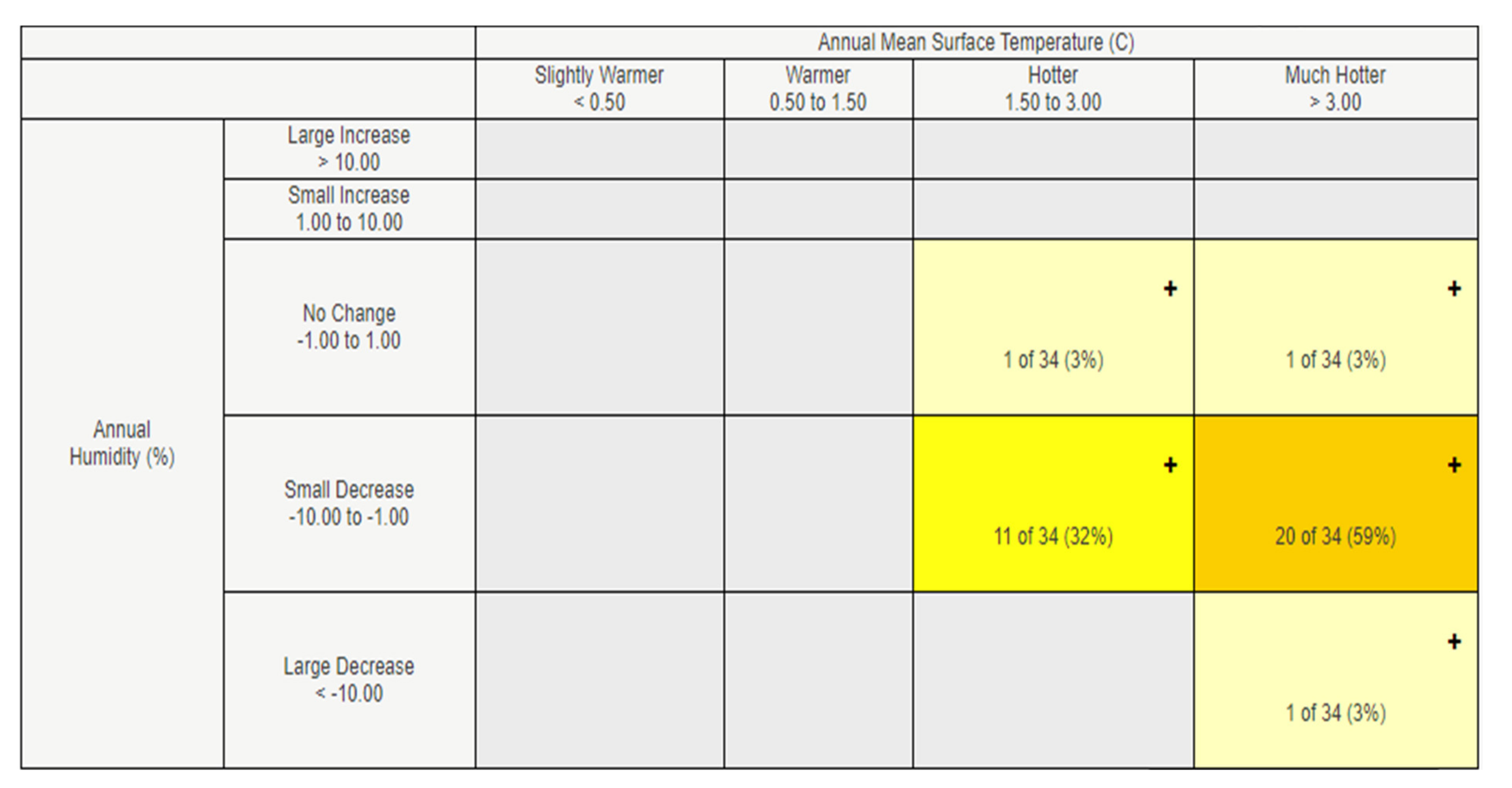
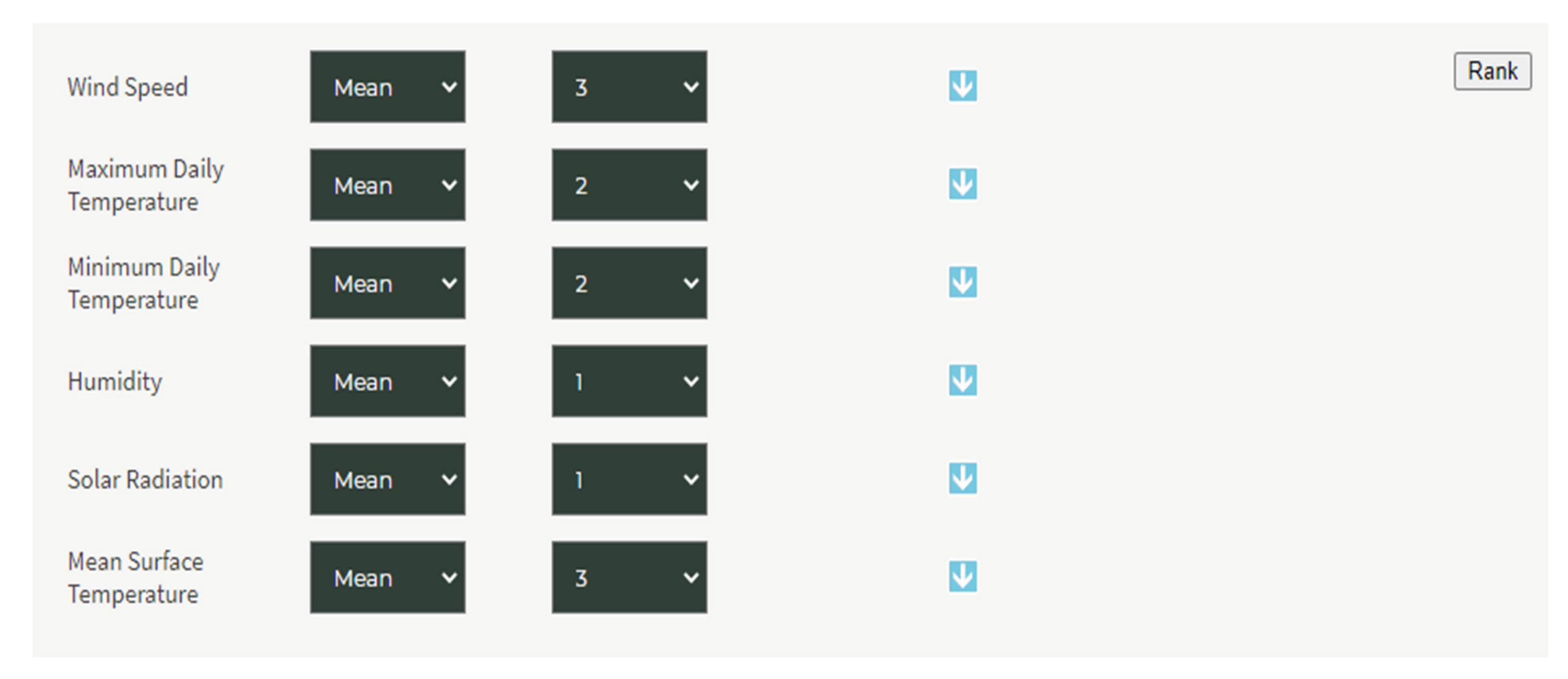

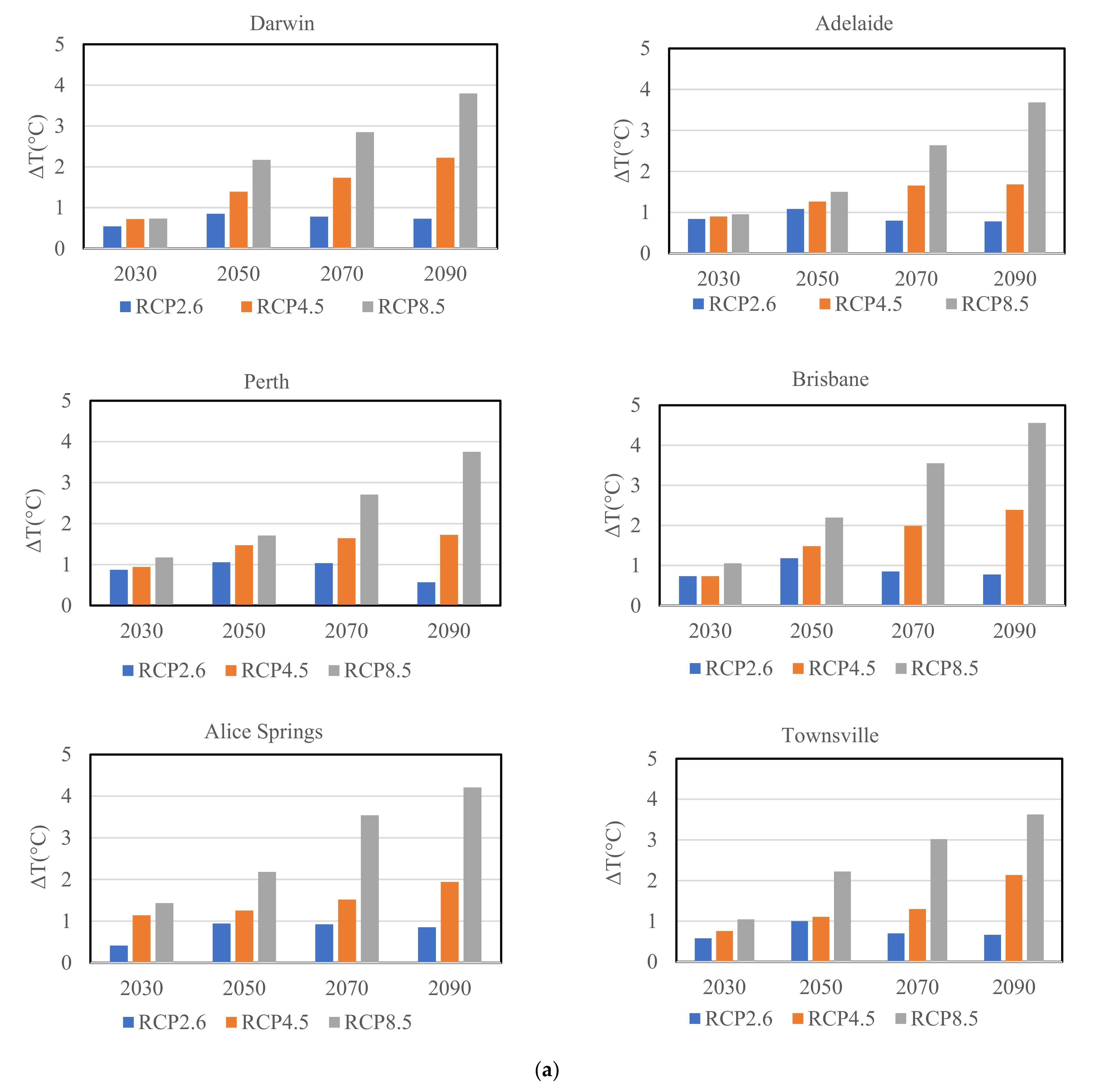

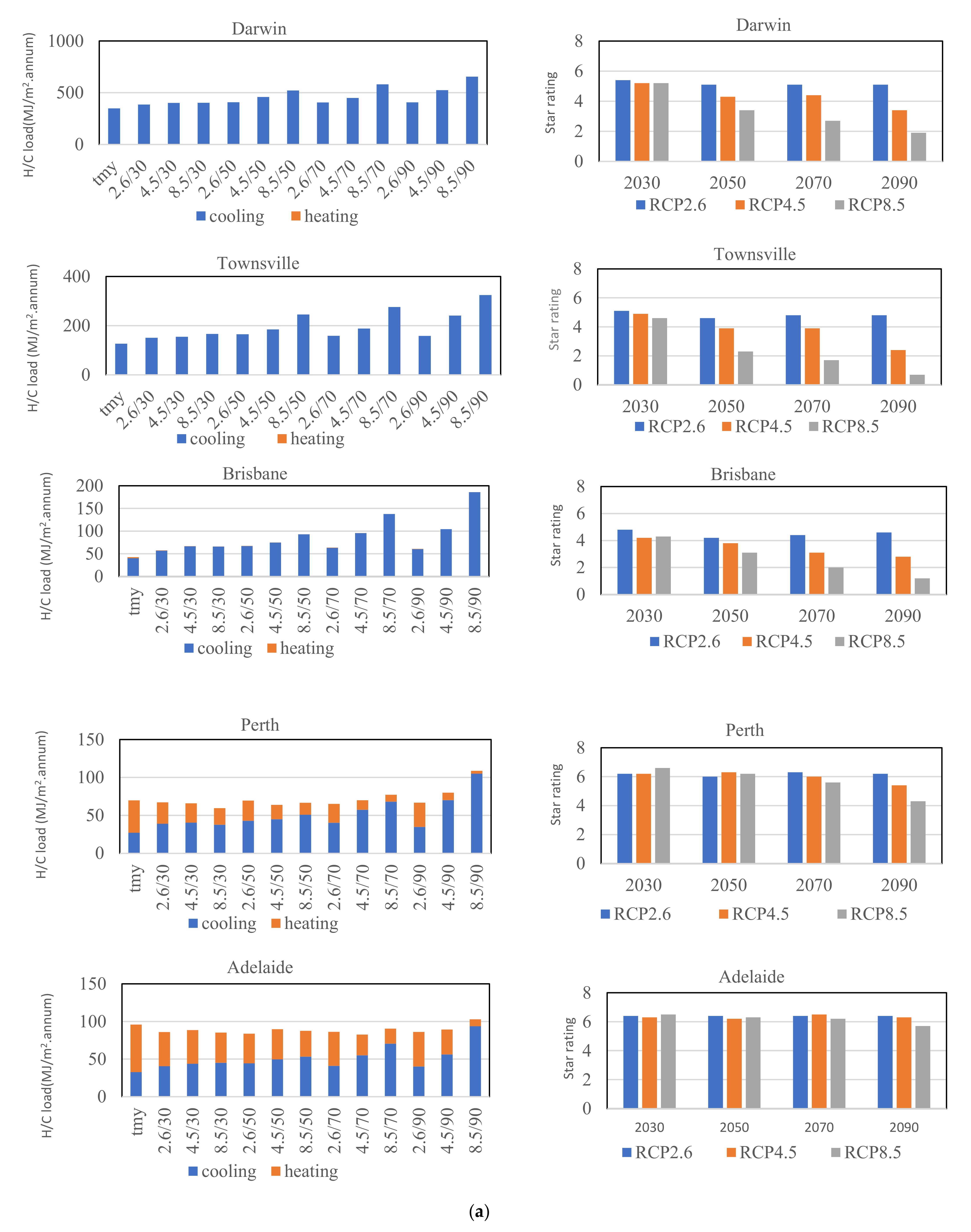
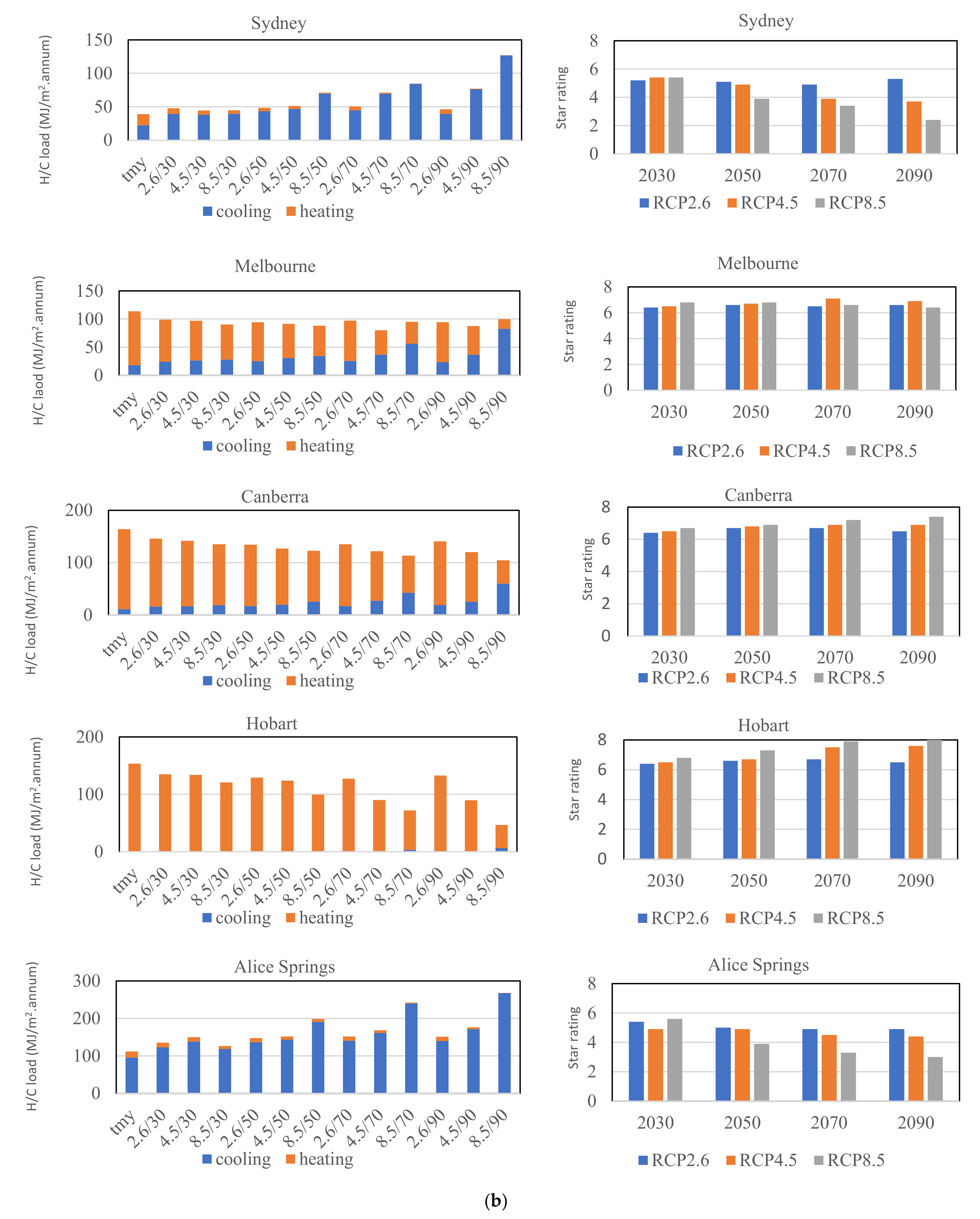
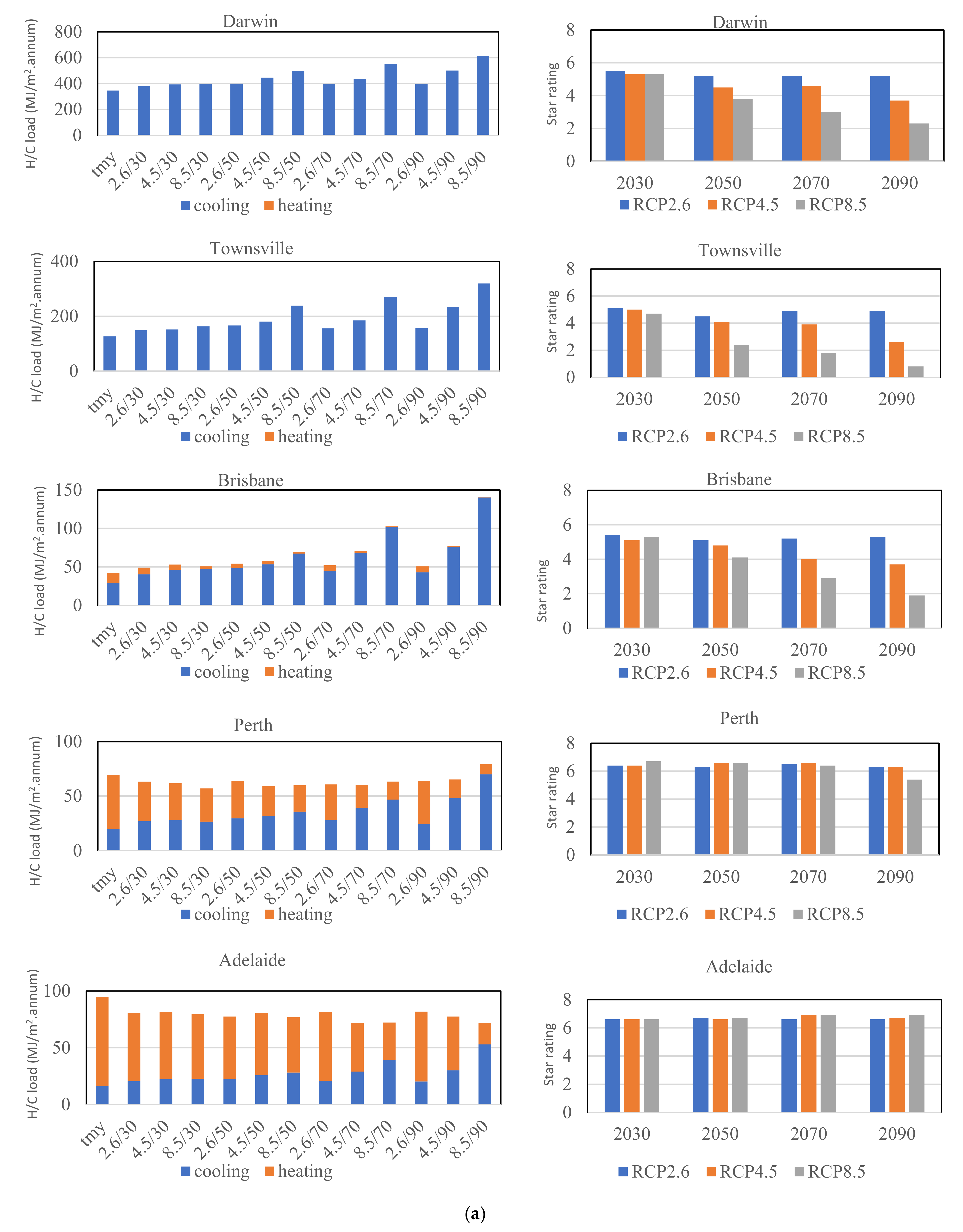
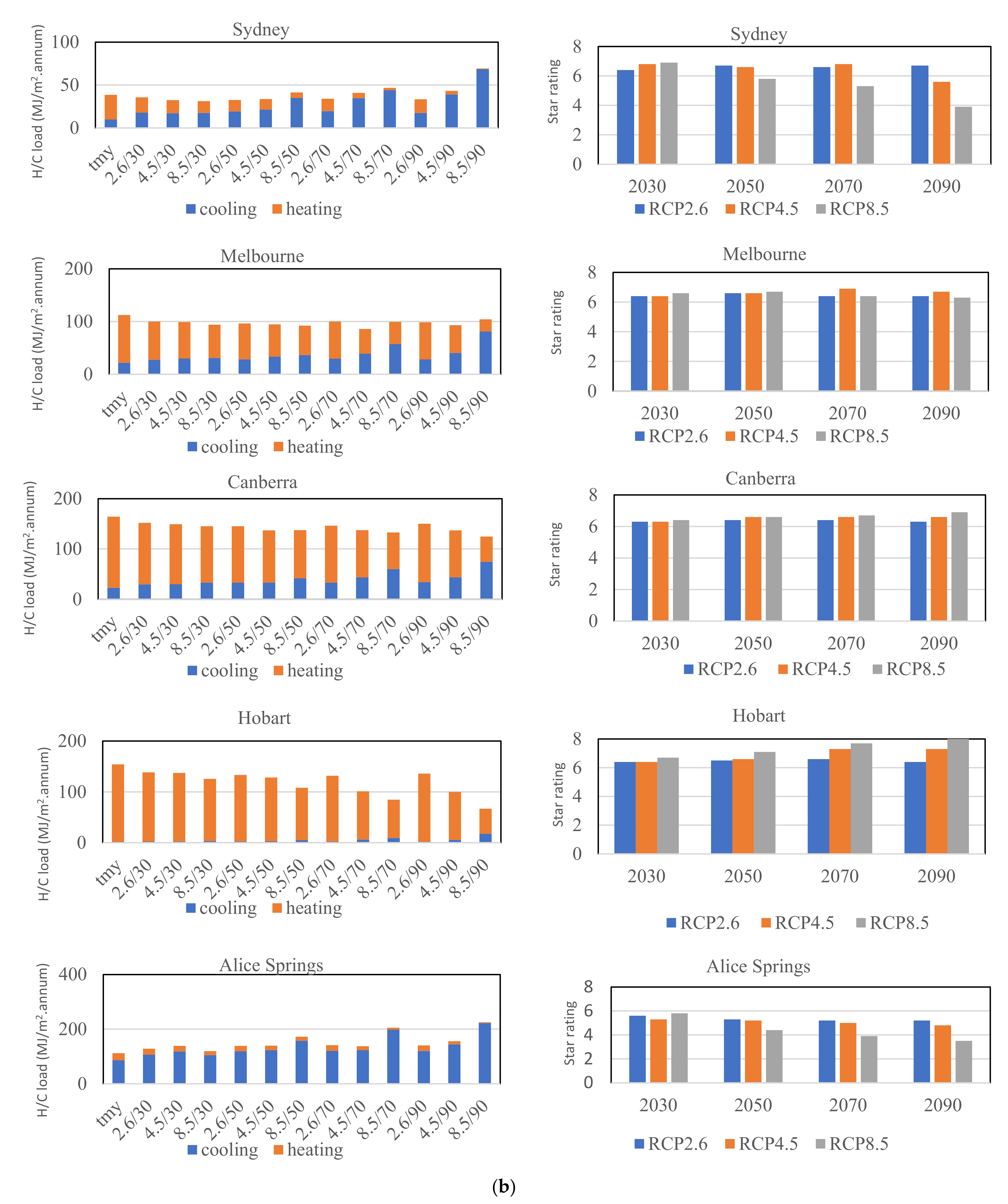
| Locations | Climate Features | Köppen Climate Classification |
|---|---|---|
| Darwin | Tropical savanna climate with distinct wet and dry seasons | Aw |
| Townsville | Tropical savanna climate | Aw |
| Alice Springs | Subtropical hot desert climate with extremely hot, dry summers and short, mild winters | BWh |
| Brisbane | Humid subtropical climate with hot, wet summers and moderately dry, warm winters | Cfa |
| Sydney | Humid subtropical climate with warm, sometimes hot summers and cool winters | Cfa |
| Perth | Hot-summer Mediterranean climate | Csa |
| Adelaide | Mediterranean climate with hot, dry summers and cool winters | Csa |
| Melbourne | Temperate oceanic climate with warm to hot summers and mild winters | Cfb |
| Canberra | Oceanic climate | Cfb |
| Hobart | Mild temperate oceanic climate with cool summers and warm winters | Cfb |
| Selected Models | Developer |
|---|---|
| ACCESS1.0 | CSIRO and the Australian Bureau of Meteorology |
| CESM1-CAM5 | The Canadian Centre for Climate Modelling and Analysis |
| CNRM-CM5 | National Science Foundation (NSF) and National Centre for Atmospheric Research, USA |
| GFDL-ESM2M | National Centre for Meteorological Research—Centre of Basic and Applied Research, France |
| HadGEM2-CC | National Oceanic and Atmospheric Administration, Geophysical Fluid Dynamics Laboratory, USA |
| CanESM2 | Met Office Hadley Centre, the UK |
| MIROC5 | Japan Agency for Marine-Earth Science and Technology |
| NorESM1-M | Nordic Construction Company, Norway |
| Climate Zone | RCP2.6 | RCP4.5 | RCP8.5 | |||||||||
|---|---|---|---|---|---|---|---|---|---|---|---|---|
| 2030s | 2050s | 2070s | 2090s | 2030s | 2050s | 2070s | 2090s | 2030s | 2050s | 2070s | 2090s | |
| Darwin | MIROC5 | MIROC5 | CNRM-CM5 | CNRM-CM5 | MIROC5 | CESM1-CAM5 | GFDL-ESM2M | CanESM | MIROC5 | CanESM | CESM1-CAM5 | CESM1-CAM5 |
| Townsville | MIROC5 | MIROC5 | CNRM-CM5 | CNRM-CM5 | HadGEM2-CC | CESM1-CAM5 | MIROC5 | CanESM | MIROC5 | CanESM | CESM1-CAM5 | CESM1-CAM5 |
| Alice Springs | CESM1-CAM5 | CESM1-CAM5 | CESM1-CAM5 | CESM1-CAM5 | ACCESS1-0 | CESM1-CAM5 | CNRM-CM5 | CESM1-CAM5 | HadGEM2-CC | ACCESS1-0 | ACCESS1-0 | CESM1-CAM5 |
| Brisbane | MIROC5 | MIROC5 | CNRM-CM5 | CNRM-CM5 | CESM1-CAM5 | CESM1-CAM5 | CanESM | CESM1-CAM5 | CESM1-CAM5 | CESM1-CAM5 | CESM1-CAM5 | CESM1-CAM5 |
| Perth | CNRM-CM5 | CNRM-CM5 | CNRM-CM5 | MIROC5 | CESM1-CAM5 | ACCESS1-0 | HadGEM2-CC | HadGEM2-CC | CESM1-CAM5 | ACCESS1-0 | HadGEM2-CC | HadGEM2-CC |
| Sydney | MIROC5 | CanESM | MIROC5 | MIROC5 | MIROC5 | MIROC5 | CanESM | CanESM | CESM1-CAM5 | CanESM | CESM1-CAM5 | CESM1-CAM5 |
| Adelaide | CNRM-CM5 | CNRM-CM5 | MIROC5 | MIROC5 | MIROC5 | ACCESS1-0 | CESM1-CAM5 | HadGEM2-CC | CESM1-CAM5 | ACCESS1-0 | HadGEM2-CC | HadGEM2-CC |
| Melbourne | CNRM-CM5 | CNRM-CM5 | MIROC5 | MIROC5 | ACCESS1-0 | ACCESS1-0 | CESM1-CAM5 | HadGEM2-CC | CESM1-CAM5 | ACCESS1-0 | HadGEM2-CC | HadGEM2-CC |
| Canberra | CNRM-CM5 | MIROC5 | MIROC5 | CNRM-CM5 | ACCESS1-0 | ACCESS1-0 | CESM1-CAM5 | HadGEM2-CC | CESM1-CAM5 | ACCESS1-0 | HadGEM2-CC | HadGEM2-CC |
| Hobart | CNRM-CM5 | CNRM-CM5 | CNRM-CM5 | MIROC5 | ACCESS1-0 | MIROC5 | CESM1-CAM5 | HadGEM2-CC | CESM1-CAM5 | ACCESS1-0 | HadGEM2-CC | HadGEM2-CC |
| Darwin | Townsville | Alice Springs | Brisbane | Sydney | Perth | Adelaide | Melbourne | Canberra | Hobart |
|---|---|---|---|---|---|---|---|---|---|
| 349 | 127 | 113 | 43 | 70 | 39 | 96 | 114 | 165 | 155 |
| Location | Periods | House 1 | House 2 | ||||
|---|---|---|---|---|---|---|---|
| RCP2.6 | RCP4.5 | RCP8.5 | RCP2.6 | RCP4.5 | RCP8.5 | ||
| Darwin | 2030s | 10.7 | 15.3 | 15.6 | 9.6 | 13.5 | 14.4 |
| 2050s | 17.2 | 31.8 | 49.8 | 15.3 | 28.6 | 43.3 | |
| 2070s | 16.6 | 29.0 | 66.9 | 14.8 | 26.5 | 59.1 | |
| 2090s | 16.8 | 50.8 | 88.2 | 14.8 | 44.5 | 77.5 | |
| Alice Springs | 2030s | 28.4 | 44.6 | 24.1 | 23.5 | 37.4 | 22.1 |
| 2050s | 42.9 | 50.1 | 99.8 | 38.0 | 43.2 | 83.5 | |
| 2070s | 47.2 | 68.6 | 151.2 | 40.6 | 43.1 | 130.6 | |
| 2090s | 46.2 | 79.4 | 179.9 | 39.5 | 68.0 | 158.4 | |
| Townsville | 2030s | 19.1 | 22.3 | 31.3 | 17.7 | 20.0 | 28.6 |
| 2050s | 30.2 | 45.7 | 93.9 | 31.4 | 42.4 | 88.2 | |
| 2070s | 25.4 | 48.5 | 117.7 | 23.1 | 45.8 | 112.7 | |
| 2090s | 24.9 | 90.3 | 156.1 | 23.3 | 84.9 | 152.3 | |
| Brisbane | 2030s | 40.9 | 64.8 | 63.3 | 39.1 | 59.2 | 63.3 |
| 2050s | 66.5 | 85.6 | 130.5 | 67.1 | 84.4 | 132.9 | |
| 2070s | 56.3 | 137.0 | 241.4 | 53.6 | 134.6 | 254.0 | |
| 2090s | 49.6 | 159.1 | 361.3 | 48.4 | 161.9 | 385.1 | |
| Sydney | 2030s | 77.0 | 71.6 | 77.9 | 81.6 | 75.5 | 77.6 |
| 2050s | 95.0 | 110.8 | 213.1 | 96.9 | 118.4 | 255.1 | |
| 2070s | 100.5 | 213.1 | 279.3 | 100.0 | 254.1 | 348.0 | |
| 2090s | 77.0 | 242.8 | 470.7 | 77.6 | 298.0 | 600.0 | |
| Perth | 2030s | 43.9 | 49.1 | 39.1 | 35.2 | 40.2 | 33.2 |
| 2050s | 57.9 | 65.7 | 87.5 | 48.2 | 59.3 | 78.9 | |
| 2070s | 48.7 | 111.4 | 150.9 | 40.2 | 97.0 | 135.2 | |
| 2090s | 28.0 | 158.7 | 287.1 | 21.1 | 141.2 | 251.3 | |
| Canberra | 2030s | 44.1 | 45.9 | 67.6 | 29.5 | 30.8 | 45.8 |
| 2050s | 53.2 | 75.7 | 128.8 | 44.5 | 44.9 | 82.8 | |
| 2070s | 53.2 | 143.2 | 282.0 | 45.8 | 90.3 | 164.3 | |
| 2090s | 69.4 | 127.0 | 436.9 | 49.8 | 91.2 | 228.2 | |
| Adelaide | 2030s | 23.9 | 33.6 | 37.9 | 26.7 | 37.9 | 41.0 |
| 2050s | 35.8 | 51.7 | 62.7 | 40.4 | 60.2 | 74.5 | |
| 2070s | 25.4 | 68.2 | 115.3 | 29.8 | 80.1 | 144.1 | |
| 2090s | 22.6 | 71.9 | 186.2 | 26.1 | 87.0 | 228.6 | |
| Melbourne | 2030s | 34.4 | 46.7 | 54.4 | 26.1 | 36.7 | 42.2 |
| 2050s | 39.4 | 70.0 | 90.0 | 29.4 | 52.3 | 67.4 | |
| 2070s | 42.2 | 103.3 | 211.1 | 34.9 | 78.9 | 161.9 | |
| 2090s | 30.0 | 103.3 | 358.3 | 28.4 | 85.8 | 271.1 | |
| Hobart | 2030s | 100.0 | 100.0 | 200.0 | 22.2 | 33.3 | 77.8 |
| 2050s | 100.0 | 200.0 | 400.0 | 38.9 | 50.0 | 172.2 | |
| 2070s | 50.0 | 550.0 | 1550.0 | 27.8 | 227.8 | 411.1 | |
| 2090s | 50.0 | 450.0 | 3000.0 | 11.1 | 205.6 | 883.3 | |
| RCP2.6 | RCP4.5 | RCP8.5 | ||||||||||
|---|---|---|---|---|---|---|---|---|---|---|---|---|
| 2030s | 2050s | 2070s | 2090s | 2030s | 2050s | 2070s | 2090s | 2030s | 2050s | 2070s | 2090s | |
| Darwin | 5.4 | 5.1 | 5.1 | 5.1 | 5.2 | 4.3 | 4.4 | 3.4 | 5.2 | 3.4 | 2.7 | 1.9 |
| Alice Springs | 5.4 | 5 | 4.9 | 4.9 | 4.9 | 4.9 | 4.5 | 4.4 | 5.6 | 3.9 | 3.3 | 3 |
| Townsville | 5.1 | 4.6 | 4.8 | 4.8 | 4.9 | 3.9 | 3.9 | 2.4 | 4.6 | 2.3 | 1.7 | 0.7 |
| Brisbane | 4.8 | 4.2 | 4.4 | 4.6 | 4.2 | 3.8 | 3.1 | 2.8 | 4.3 | 3.1 | 2 | 1.2 |
| Perth | 6.2 | 6 | 6.3 | 6.2 | 6.2 | 6.3 | 6 | 5.4 | 6.6 | 6.2 | 5.6 | 4.3 |
| Sydney | 5.2 | 5.1 | 4.9 | 5.3 | 5.4 | 4.9 | 3.9 | 3.7 | 5.4 | 3.9 | 3.4 | 2.4 |
| Adelaide | 6.4 | 6.4 | 6.4 | 6.4 | 6.3 | 6.2 | 6.5 | 6.3 | 6.5 | 6.3 | 6.2 | 5.7 |
| Melbourne | 6.4 | 6.6 | 6.4 | 6.4 | 6.4 | 6.6 | 6.9 | 6.7 | 6.6 | 6.7 | 6.4 | 6.3 |
| Canberra | 6.3 | 6.4 | 6.4 | 6.3 | 6.3 | 6.6 | 6.6 | 6.6 | 6.4 | 6.6 | 6.7 | 6.9 |
| Hobart | 6.4 | 6.6 | 6.7 | 6.5 | 6.5 | 6.7 | 7.5 | 7.6 | 6.8 | 7.3 | 7.9 | 8.6 |
| RCP2.6 | RCP4.5 | RCP8.5 | ||||||||||
|---|---|---|---|---|---|---|---|---|---|---|---|---|
| 2030s | 2050s | 2070s | 2090s | 2030s | 2050s | 2070s | 2090s | 2030s | 2050s | 2070s | 2090s | |
| Darwin | 5.5 | 5.2 | 5.2 | 5.2 | 5.3 | 4.5 | 4.6 | 3.7 | 5.3 | 3.8 | 3 | 2.3 |
| Alice Springs | 5.6 | 5.3 | 5.2 | 5.2 | 5.3 | 5.2 | 5 | 4.8 | 5.8 | 4.4 | 3.9 | 3.5 |
| Townsville | 5.1 | 4.5 | 4.9 | 4.9 | 5 | 4.1 | 3.9 | 2.6 | 4.7 | 2.4 | 1.8 | 0.8 |
| Brisbane | 5.4 | 5.1 | 5.2 | 5.3 | 5.1 | 4.8 | 4 | 3.7 | 5.3 | 4.1 | 2.9 | 1.9 |
| Perth | 6.4 | 6.3 | 6.5 | 6.3 | 6.4 | 6.6 | 6.6 | 6.3 | 6.7 | 6.6 | 6.4 | 5.4 |
| Sydney | 6.4 | 6.7 | 6.6 | 6.7 | 6.8 | 6.6 | 6.8 | 5.6 | 6.9 | 5.8 | 5.3 | 3.9 |
| Adelaide | 6.6 | 6.7 | 6.6 | 6.6 | 6.6 | 6.6 | 6.9 | 6.7 | 6.6 | 6.7 | 6.9 | 6.9 |
| Melbourne | 6.4 | 6.6 | 6.4 | 6.4 | 6.4 | 6.6 | 6.9 | 6.7 | 6.6 | 6.7 | 6.4 | 6.3 |
| Canberra | 6.3 | 6.4 | 6.4 | 6.3 | 6.3 | 6.6 | 6.6 | 6.6 | 6.4 | 6.6 | 6.7 | 6.9 |
| Hobart | 6.4 | 6.5 | 6.6 | 6.4 | 6.4 | 6.6 | 7.3 | 7.3 | 6.7 | 7.1 | 7.7 | 8.1 |
Publisher’s Note: MDPI stays neutral with regard to jurisdictional claims in published maps and institutional affiliations. |
© 2021 by the authors. Licensee MDPI, Basel, Switzerland. This article is an open access article distributed under the terms and conditions of the Creative Commons Attribution (CC BY) license (https://creativecommons.org/licenses/by/4.0/).
Share and Cite
Chen, S.; Ren, Z.; Tang, Z.; Zhuo, X. Long-Term Prediction of Weather for Analysis of Residential Building Energy Consumption in Australia. Energies 2021, 14, 4805. https://doi.org/10.3390/en14164805
Chen S, Ren Z, Tang Z, Zhuo X. Long-Term Prediction of Weather for Analysis of Residential Building Energy Consumption in Australia. Energies. 2021; 14(16):4805. https://doi.org/10.3390/en14164805
Chicago/Turabian StyleChen, Shu, Zhengen Ren, Zhi Tang, and Xianrong Zhuo. 2021. "Long-Term Prediction of Weather for Analysis of Residential Building Energy Consumption in Australia" Energies 14, no. 16: 4805. https://doi.org/10.3390/en14164805
APA StyleChen, S., Ren, Z., Tang, Z., & Zhuo, X. (2021). Long-Term Prediction of Weather for Analysis of Residential Building Energy Consumption in Australia. Energies, 14(16), 4805. https://doi.org/10.3390/en14164805






